Heybike Mars 3.0 Review | A Fast, Far-Out, Full-Sus Folder
This high-powered, extra-cushioned folding e-bike could give industry titans like Lectric a run for their money!
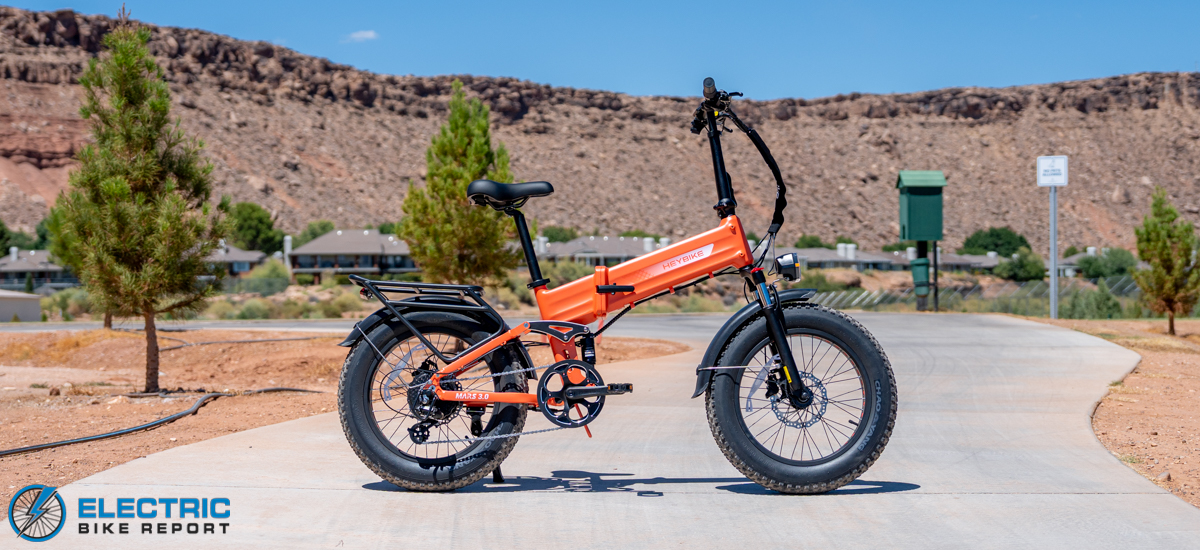
In a time when prices are on the rise, every big manufacturer of entry-level folding e-bikes is competing to make the best bike with the most features at the lowest price. After all, entry-level folding e-bikes are extremely popular, and for good reason, too!
They’re often cost-effective, versatile, and, of course, compact; they can occupy an empty nook in the garage or a storage compartment in an RV. They’re often priced between $1,000 and $ 1,500, able to haul a hefty load of cargo or a passenger, and capable of venturing off the beaten path while camping or cruising the paved roads of a new city.
As part of Heybike’s newest X-Series of redesigned folding models, the Mars 3.0 claims to be among “The Pinnacle of Folding Fat-tire E-Bikes.” At least, that’s the idea, and it just so happens that our team of testers and reviewers is here to evaluate the brand’s bold statement.
It’s hard to deny that, at least on paper, the bike brings a lot to the table. For starters, it’s priced around $1,300, and it includes such highlights as a 1400W peak hub motor paired with a torque sensor, a full suspension, and Bluetooth pairing with the Heybike app. It also features front and rear turn-signals, a color-coded display, and a 440 lb payload capacity.
But what about the bike’s real-world performance? Is it as fast as Heybike claims it to be? Is it comfortable to ride? And how many miles can its battery last?
These are just a few of the questions that our team of experts set out to answer through a series of standardized tests. See our full review below to find out if this bike offers as much bang for the buck as we hoped it would at first glance!
Class 2 (throttle to 20 mph)
Class 3 (pedal assist to 28 mph)
 Pros
Pros- At its competitive price point of around $1,300, the Mars 3.0 offers tremendous value! Its spec sheet is very impressive for its cost.
- With a powerful 750W motor and torque sensor, the Mars provides ample and responsive pedal assistance that adapts to your level of effort.
- The ride is cushioned well by the bike’s full suspension (an uncommon feature on folding e-bikes), which includes a fork with 65mm of travel and a shock with 30mm of stroke.
- Another uncommon feature for the price, the Mars 3.0 pairs with the Heybike App, which offers customization over speed, throttle behavior, the number of assist levels, and more.
- The bike’s color-coded TFT display looks great, presenting organized ride data and offering security through a 4-digit PIN, a keycard, or the Heybike App.
- While many similar bikes ride on narrower tires, the Mars’ 20×4” fat tires maximize stability and cushioning while riding.
- The Mars 3.0 is one of only a few folding e-bikes we’ve tested with both front and rear turn signals.
- Its total weight capacity of 440 lbs is among the highest we’ve seen on a bike of this style! The sturdy frame felt plenty capable of supporting a large payload.
 Cons
Cons- The battery requires a key to remain inserted for the bike to ride. We’d prefer to be able to remove it after the battery is turned on.
- The display’s fluctuating battery percentage made it difficult to know how much power was remaining. We encourage Heybike to use a screen with a more reliable readout.
- Raising the bike’s pedal-assisted speed above 20 mph also increased its throttle speed above legal limits. The ability to adjust each separately would ensure that the Mars 3.0 meets Class-based restrictions.
- Battery:48V, 624 Wh
- Display: TFT display, NFC card-enabled startup, IP65 rated
- Motor: 750W Hub Motor (1400W peak), 95 Nm torque
- Headlight: LED Frontlight with Horn, Turn Signals
- Taillights:Taillight with Brake & Turn Signals
- Pedal Assist: PAS 1-5, Torque Sensor
- Claimed Range: Up to 65 miles
- Throttle:Half Twist Throttle
- App:Heybike Smart APP for iOS & Android
- UL Certification: TUV Certified in accordance with UL 2849
- Claimed weight: 70 lbs
- Tested Weight: 71.7 lbs
- Rider height range: 4’11” – 6’2″
- Total payload capacity: 440 lbs
- Brakes:Hydraulic Disc Brake, 180×2.0mm Rotor
- Fenders:Included
- Fork:Hydraulic Front Suspension Fork 65mm Travel
- Frame: 6061 Aluminum Alloy Frame
- Drivetrain:Shimano Altus 8-Speed Gear, 48T chainring, 13-32T cassette
- Grips: Rubber
- Saddle: Custom
- Handlebar: 630mm
- Kickstand: Included
- Pedals: Folding Plastic
- Tires: 20”x 4” Fat Tires
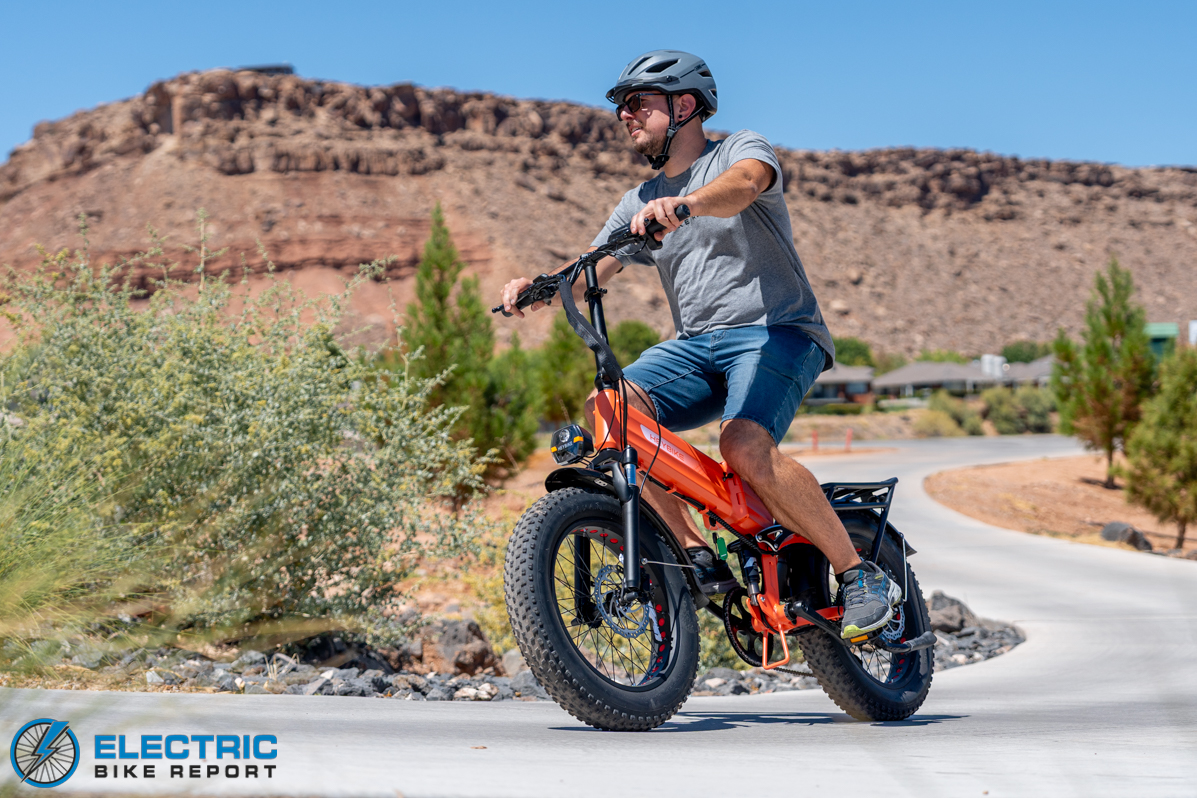
The bike ships with a 20 mph speed limit, but our testing showed it can reach speeds of around 32 mph once unlocked through the app/display menu.
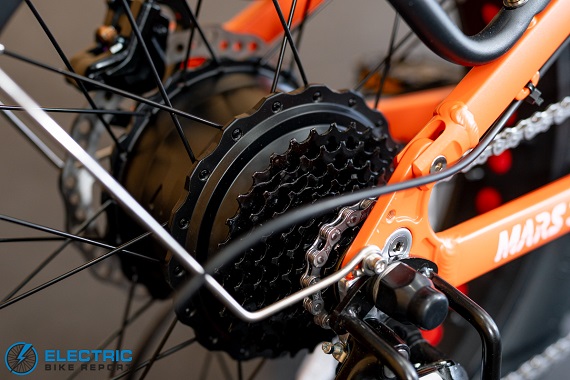
A 750W motor propels the bike, making the ride fast and easy with its 95 Nm of torque and peak of 1,400W.
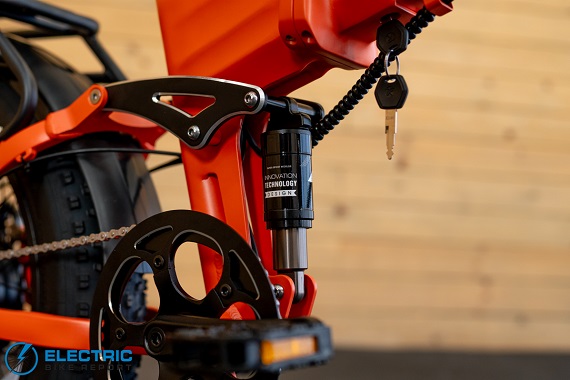
The Mars 3.0’s rear shock helps to make the ride smooth and cushy on dirt and paved paths alike.
Heybike Mars 3.0 Review: Speed Test
Knowing how fast an e-bike can go is an important first step when considering one. The Mars 3.0 ships as a Class 2 e-bike with a maximum speed of 20 mph for both its throttle and pedal-assist system (PAS), but Heybike also advertises a 28 mph maximum and the ability to increase its limit to over 30 mph through the display.
To test the bike, I rode it on a flat section of our local shared-use trail system. I pedaled the Mars 3.0 in each of its five assist settings in both Class 2 and Class 3 modes. I also tested the bike with all restrictions removed to find its absolute top speed and evaluated its throttle acceleration separately in a final test.
The data from my Class 2 and Class 3 pedal tests are shown in the graph above.
During my initial testing of the Mars 3.0, I quickly discovered that the bike had preset (and also customizable) speed limits through the Heybike App. As such, the motor delivered power to bring me up to those limits (plentifully, I might add) while responding and adapting rapidly to the amount of pressure I applied to the pedals.
With a maximum speed of 20 mph, the preset speed limits were:
- Eco – 11 mph
- Tour – 13 mph
- Standard – 16 mph
- Sport – 18 mph
- Turbo – 20 mph
As the graph shows, the bike stayed relatively true to its programmed limitations in the Eco assist level, but it exceeded the numbers above by 1-1.5 mph in all other settings.
When set to a maximum of 28 mph, the limitations of the PAS settings shifted automatically to redistribute its speeds as follows:
- Eco – 15 mph
- Tour – 18 mph
- Standard – 22 mph
- Sport – 25 mph
- Turbo – 28 mph
Once again, as shown in the graph, the bike’s real-world speed matched its programmed limitations to start, and then fell relatively close in the Standard and Turbo assist levels. In Tour and Sport modes, however, it exceeded the programmed speeds by 1-2 mph.
Discrepancies aside, the Mars 3.0’s speeds were relatively well balanced across all five assist levels. With roughly consistent increases in speed between each setting, riders have a granular level of control over how fast they ride, and it’s also possible to apply the same limitations to the throttle for a similarly controlled ride.
I identified a couple of points of critique in this test.
First, we’d prefer the bike’s speed limits to have greater accuracy in relation to the programmed settings. Second, the maximum PAS and throttle speeds are tied together, meaning that the throttle exceeded legal limitations when the PAS was set to 28 mph. We encourage Heybike to allow users to adjust the throttle and PAS speeds separately.
As a word of caution, potential buyers should also be aware that the Mars can be relatively punchy. On a couple of occasions, the quickly ramping-up acceleration force caught me somewhat off guard. Once I knew to expect it, however, I enjoyed the bike’s peppy, powerful feel.
This quick acceleration, which can be adjusted through a setting in the display menu, was apparent when testing the bike’s throttle. Figuratively speaking, the Mars jumped off the line when engaging its throttle and quickly reached top speed.
Speaking of top speed, I tested the bike’s unrestricted maximum speed; when adjusted through the display (which functions in km/h), I could throttle or pedal up to roughly 32 mph.
Overall, the Mars 3.0 proved to be fast, powerful, and largely customizable. We identified a couple of areas with room for improvement, but we appreciated the standard distribution of speeds/power levels, the responsiveness of its PAS, and the ease with which its speed limitations could be adjusted.
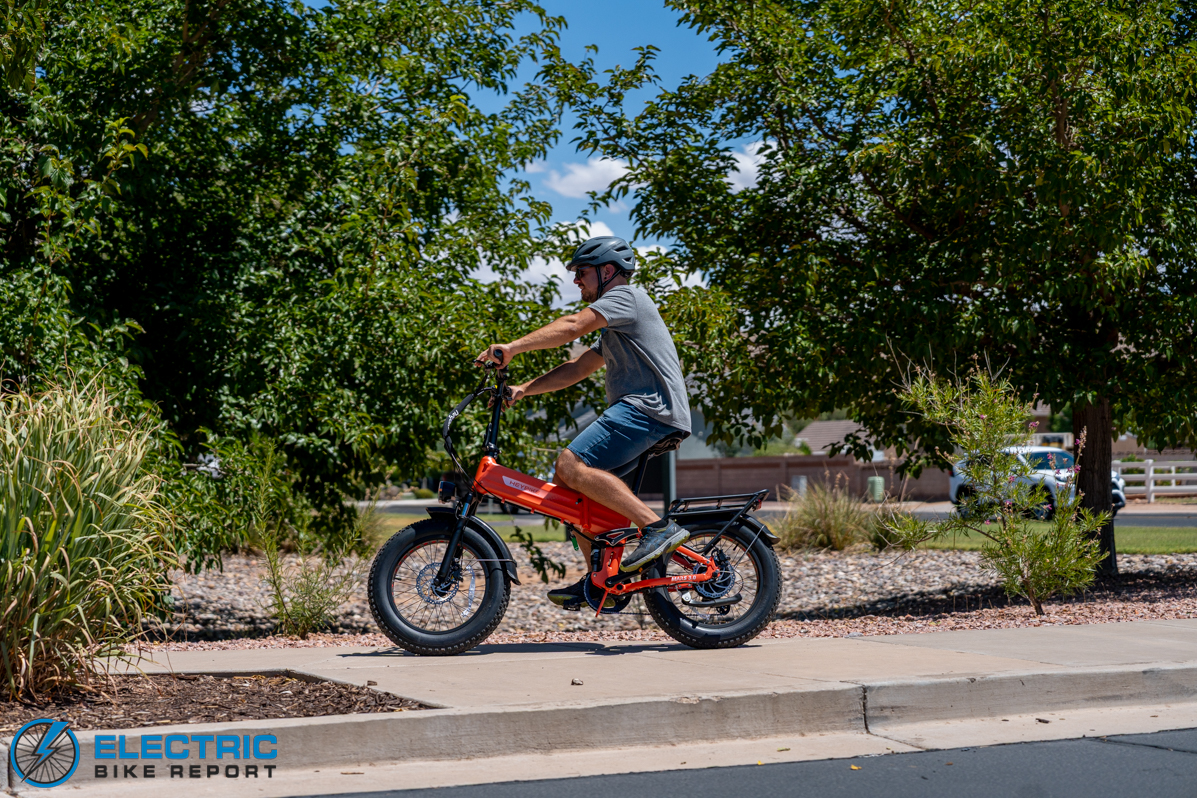
A few key specs for the folded bike: the Mars 3.0 weighs roughly 72 lbs, including its 9-lb battery, and folds down to around 40”L x 21”W x 32.5”H.
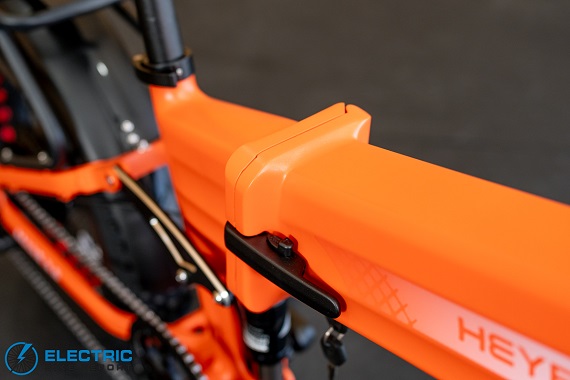
The bike’s 48V, 624 Wh battery is contained within the down tube and accessible when the central hinge is open.
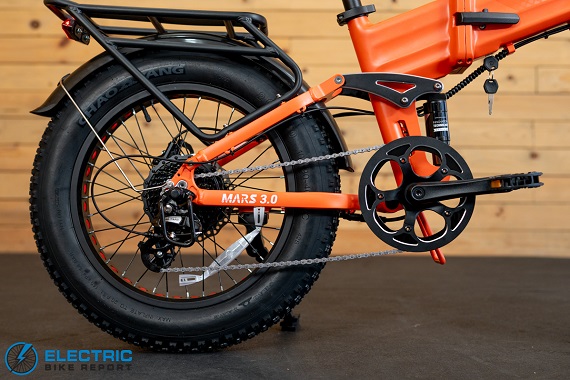
An 8-speed Shimano Altus drivetrain provides a good gearing range for the bike’s speeds.
Heybike Mars 3.0 Review: Range Test
As you might expect, the goal of our Range Test is to determine how far a bike can travel on a single charge of its battery. The process we use for this test is explained in the graphic above, along with the Heybike Mars 3.0’s results.
As a point of clarification, we expect the bike to be capable of reaching Heybike’s advertised range of 65 miles. Our team is regularly shuffling bikes between riders, and in this case, we inadvertently set the Mars to its Class 3 mode before the final 9-mile leg of our Eco mode range test. This increased our test rider’s speed and required more power than when it was limited to 20 mph for earlier portions of the test.
The Mars 3.0 performed very well, with minimum and maximum results that closely matched the averages of a pool of similar models, which include the best folding e-bikes we’ve tested. Those bikes averaged 59.8 miles in their low-power tests and 29.1 miles in their max-PAS tests.
It’s worth noting that, on average, the pool of e-bikes used for comparison had larger batteries. While their power packs averaged 667 watt-hours (Wh), the Mars 3.0 was equipped with a 624 Wh battery, which puts its average performance in a different perspective, making it more impressive overall.
Looking closer at its test scores, we can divide its battery capacity in watt-hours by its mileage in each test to find the number of watt-hours used per mile (Wh/mi).
The bike’s test results line up well with the efficiency of its motor as shown by this approach; the Mars 3.0 used 10.2 and 18.2 Wh/mi in its low and high-power tests, respectively, while similar models used 11.2 and 22.9 Wh/mi. By using fewer watt-hours per mile, the bike was able to travel as far as (or slightly farther than) similar models with larger batteries.
Our test riders encountered some difficulties relating to the bike’s display during this test. The battery readout fluctuated significantly in response to the motor’s instantaneous demands. This made it difficult to determine the remaining charge in the battery; we encourage Heybike to adjust the display’s programming to convey its charge level more accurately and reliably.
Otherwise, considering the versatility of folding e-bikes, the results of this test demonstrate that the Mars 3.0 is well-equipped for commuting, running errands, exploring campgrounds, riding on multi-use trails, and more.
A final note: The Mars ships with a standard 2-amp charger that should take approximately 6.5 hours to charge a fully drained battery.
Heybike Mars 3.0 Review: Hill Test
We tested the Mars 3.0’s ability to climb hills using the method explained above, and found that it was capable when using both its throttle and its highest level of pedal assistance. The bike’s times were nearly identical with both approaches; its 1:53 result in the throttle test differed from its 1:53 pedal result by just two seconds.
We moved our Hill Test to the Devil’s Backbone within only a couple of months of this test; as such, we have not tested a large number of similar models at the new location.
In comparison to a small group of similar models (shown in the graphic above), which averaged 1:56 in the throttle test and 1:57 when pedaling, the Mars 3.0’s performance was slightly above average.
When only compared with other folding e-bikes with 750W motors, however, it was somewhat slower; the two bikes with more comparable specs averaged 1:44 and 1:54, respectively, making the Mars average to slightly below-average in comparison.
An e-bike’s peak power in watts (W) and torque in Newton meters (Nm) are major factors influencing its climbing ability.
Heybike states that the Mars 3.0’s 750W motor peaks at an impressive 1,400W and produces 95 Nm of torque, while the other models with 750W motors used for comparison averaged a peak of 1,180W and 80 Nm of torque.
Clearly, the Mars 3.0 is powerful enough to conquer hills that riders on analog bikes or less-powerful e-bikes might struggle to climb. Considering its relatively average weight of 72 lbs (other bikes weighed 70 lbs) and above-average motor power, however, we anticipated that its results would be noticeably faster than those of its competitors.
Still, the bike performed well in my personal testing; its throttle felt powerful and confident, and my experience when pedaling was relaxed and low-effort. With that in mind, the Mars passed our test with results that reflect its capabilities; it’s able to give riders the option to throttle or pedal over intimidating hills with relative ease.
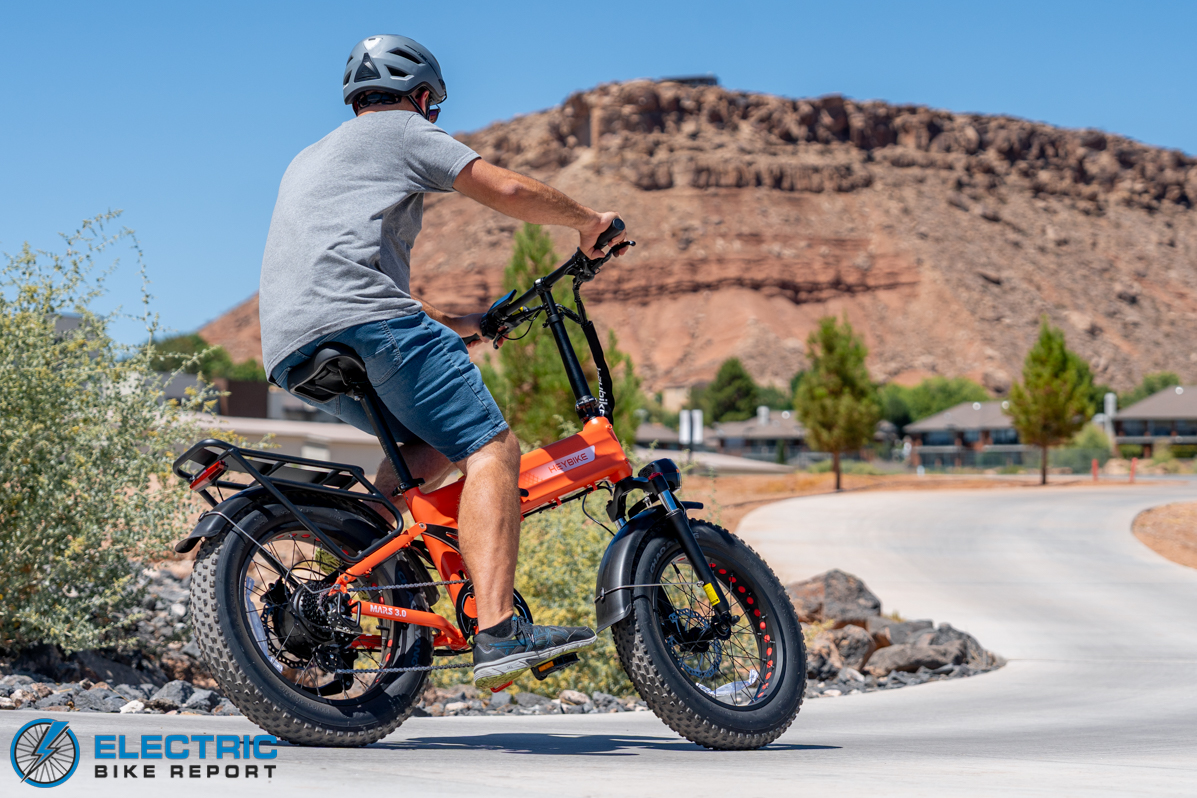
Heybike offers the Mars 3.0 in three color options: Vivid Orange (pictured), Stormy Blue, and Nightrider Black.
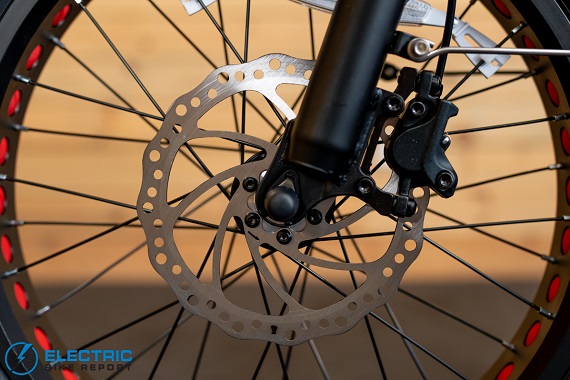
The bike’s hydraulic disc brake system features 2-piston calipers and 1.9mm rotors (according to our measurements).
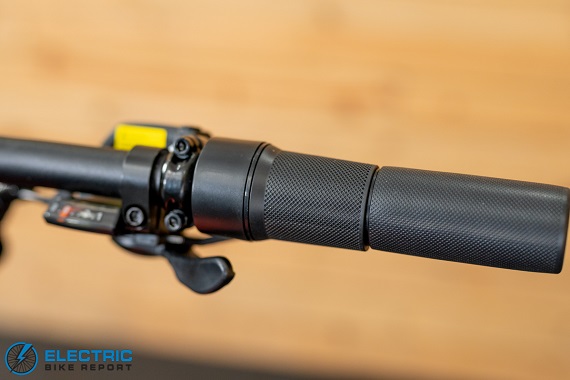
The bike’s twist throttle is on the right handlebar and functions as part of the grip.
Heybike Mars 3.0 Review: Brake Test

The Mars 3.0 is equipped with hydraulic disc brakes (one of this model’s major upgrades over the last version of the bike, the Heybike Mars 2.0) with 2-piston calipers and 180mm rotors. We tested this brake system using the method above, and averaged our three test results for a final score of 20’8”.
A relatively large pool of similar (and similarly-equipped) folding e-bikes averaged a stopping distance of 19’11” in this test. This group included a couple of overachievers that exceeded the performance of nearly all e-bikes we’ve tested, so with those removed from our dataset, the folding category average increased slightly to 20’8”, matching the Mars 3.0.
Some elements of the bike’s unbranded brake system appear similar to those of other models we’ve tested from Tektro, one of the most prominent manufacturers of bicycle and e-bike brakes. If the system is indeed made by such a reputable company, its great performance makes sense.
It’s worth noting that the Mars’s rotors are somewhat thicker than average, which likely contributed to the brake system’s effectiveness. Heybike advertises the rotors as 2mm thick (we measured 1.9mm) instead of the more common 1.8mm thickness, which would make them slightly better at dispersing heat and able to stop the bike faster.
I found the brakes’ performance to be quite powerful and effective in my testing; they brought the bike to a halt quickly and somewhat aggressively, so I expected it to perform well in this test. I was glad to be correct!
Our braking results show that the Mars is well-equipped with safe and capable brakes, so we gladly give the bike our stamp of approval in this test.
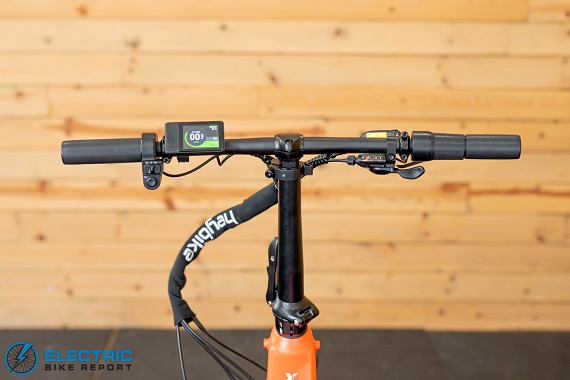
The bike’s 630mm handlebars are mounted on a telescoping stem with 5.5” of height adjustment.

The 65mm suspension fork includes lockout and preload adjustment features.
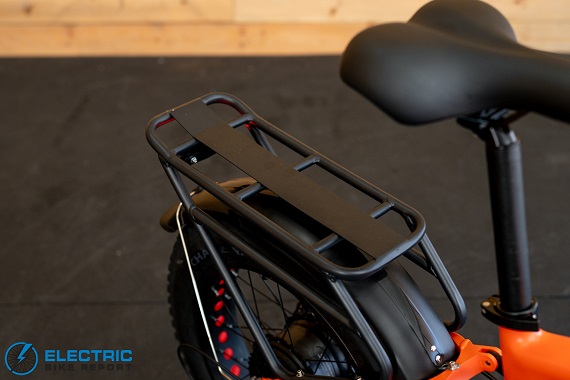
A cargo rack mounted over the rear wheel offers up to 100 lbs of carrying capacity and can carry a cargo basket, panniers, etc.

We wouldn’t mind seeing Heybike move to a 0-degree stem in the future to bring the handlebars closer to the rider.
Heybike Mars 3.0 Review: Ride Quality
In this section, I’ll examine many of the elements that contribute to how the Mars 3.0 feels to ride. Overall, the bike felt comfortable and well-equipped; however, there were a handful of areas that could be improved.
In terms of sizing and fit, Heybike offers a single step-over frame size for riders between 4’11” and 6’2”. Our contact at the company shared that, more specifically, it is intended for those with inseams between 23.6 and 31.5 inches.
At 5’11” (and with a roughly 31” inseam), I am on the high end of the recommended height range. I rode with the saddle at its tallest position (the seatpost offers an 8.5” height range) and its handlebars raised to roughly half of their 5.5” range of adjustment.
I found the bike comfortable to ride and easy to pedal, though the seatpost did not allow me to get full leg extension when pedaling; my knees were noticeably bent.
I typically prefer a higher saddle, but I found the motor powerful enough and the PAS sensitive enough to compensate for any lack of pedal efficiency. The motor dished out a lot of power with relatively light pressure applied to the pedals, so I experienced no discomfort in my knees.
The bike’s reach is long, so my arms were fully outstretched without my elbows being locked. This follows the style of many similar folding e-bikes we’ve reviewed, so the Mars does nothing out of the norm, but we prefer the more relaxed positioning of e-bikes like the Lectric XP4, which uses a 0-degree stem (in line with the bike’s head tube) to bring the handlebars closer to the rider, and we encourage Heybike to do the same in the future.
A highlight of the Mars 3.0 is its full suspension! The bike’s 65mm suspension fork takes care of most of the cushioning on the front end, while its rear shock, which offers 30mm of stroke, absorbs bumps beneath the rider. In addition to paved streets and paths, I tested the bike on dirt and gravel roads, and found its ride smooth and comfortable in all cases.
Its handling was expectedly quick and nimble, thanks to the bike’s 20” wheels and 630mm handlebars. Folding e-bikes with a similar size and relatively narrow handlebars can sometimes be described as twitchy in their steering, but the Mars 3.0’s weight and sturdy frame helped to balance this out.
The bike’s 4” tires are worth mentioning. Most folding e-bikes we’ve tested recently came equipped with narrower 3” tires, which we like, but the Mars’s wider tires offer more stability, comfort, and traction on loose terrain. They do add some weight, but we found them a nice complement to the bike’s full suspension.
Noise can be bothersome for some riders, so I want to mention that the bike could be somewhat loud at times. The motor made a moderate but noticeable (and not unusual) hum. The rear suspension on our test bike was a little creaky, but the sound lessened with use and did not affect performance.
One aspect of the bike that we didn’t like was the requirement for a key to be inserted into the battery while riding. The key is secured in place, so it is unlikely that it would fall out while riding, but we found it both somewhat inconvenient and unnecessary, considering that the Mars 3.0’s display requires either a 4-digit PIN or keycard to activate the bike.
Aside from the aforementioned battery readout inconsistencies, I was a big fan of the Mars 3.0’s display! Its size, overall design, and color-coded pedal assist levels made it a big step up from the basic black-and-white screens we’ve tested on most previous models from Heybike. The security PIN/keycard requirements are also a welcome bonus, not commonly found on e-bikes in this price range.
I mentioned previously that the bike’s speeds could be customized through the Heybike mobile app. The app, another relatively uncommon feature on similarly priced folding e-bikes, also offers ride data tracking and syncs with Apple Maps or Google Maps for navigation.
Many other customization settings can be accessed through the bike’s display. The bike’s settings menu offers options for the number of assist settings, the sensitivity of the torque sensor, the acceleration force of the motor, and many others. It’s complex but robust and relatively easy to read and understand.
The Mars 3.0 is well equipped with a cargo rack that can carry up to 100 lbs, as well as fenders, turn signals, and an electronic horn. It’s also compatible with a variety of accessories, including panniers, a cargo basket, etc. Our contact at Heybike also shared that more unique accessories, such as a golf bag carrier and surfboard rack, are currently in development.
As a folding e-bike, the Mars is relatively average in how it compacts. At 72 lbs, including its 9-lb battery, it is on the heavier side, but no more so than many similar models on the market. The hinge on our test bike was somewhat stiff, but otherwise, it functioned well. The bike’s folded dimensions measured roughly 40”L x 21”W x 32.5”H.
All in all, I consider the Mars 3.0’s ride quality to be very solid for its price; the bike is comfortable, well-equipped with a great range of specs and features, and most importantly, fun and easy to ride.

The bike’s color-coded display/control panel sits on the left handlebar next to a module for the turn signals and horn.
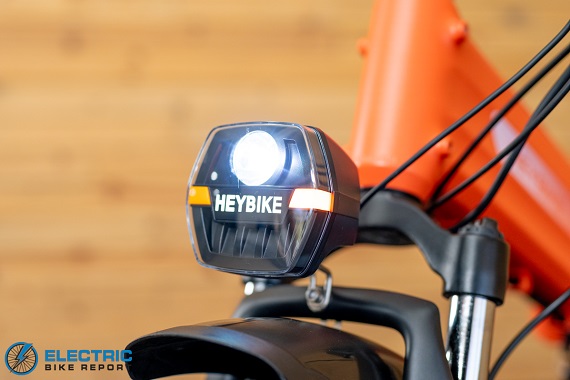
We liked the LED headlight, which includes front turn signals (a relatively rare feature on any e-bike) for safety!
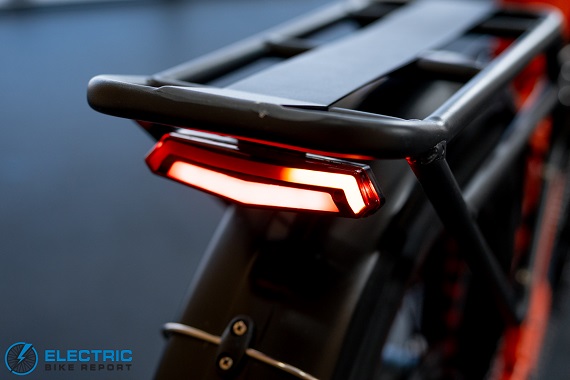
The bike’s tail light, which functions as a brake light, is mounted to the cargo rack and also includes rear turn signals.
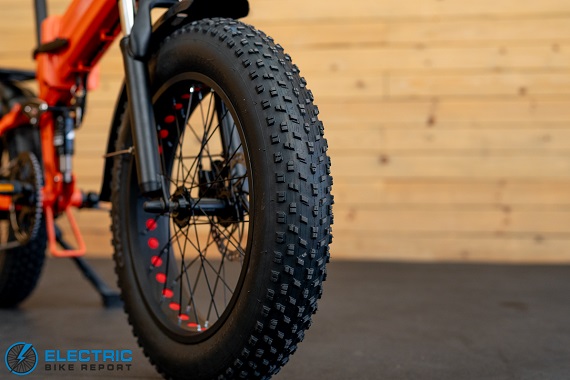
Knobby 20×4” fat tires make the ride feel stable, soft, and grippy when riding on loose terrain.
Heybike Mars 3.0 Review: Summary / Where to Buy
One of the best parts of my job as an e-bike reviewer is seeing brands evolve. In my previous experiences with Heybike products, the brand had a solid foundation and a clear aim, but it wasn’t always the most successful in its execution. The bikes were often loaded with appealing features but lacked some refinement.
To me, the Mars 3.0 marks a significant leap forward for Heybike; it’s a generally well-put-together e-bike that offers an excellent balance between value and performance. It’s also one of the best-feeling Heybike models to ride that we’ve tested yet.
When it comes to the basics, the bike is speedy, powerful, comfortable, and adaptable. In our series of performance tests, it showed a good distribution of speeds across its pedal assist system, along with great range, reliable stopping power, and solid climbing ability.
The bike’s full suspension and ability to reach speeds in excess of 28 mph will likely be appealing to thrill-seeking, adventurous riders, while its cargo rack and folding frame add versatility and utility to how and where it can be used. The bike’s price point of around $1,300 makes it a great purchase for a first e-bike or an addition to the family’s fleet.
Of course, the good must also be balanced with critique. We identified a few key (pun intended) areas with room for improvement, including the requirement for a key to stay in the battery while riding, the accuracy of the battery charge indicator on the display, and the fact that increasing the PAS speed can also raise throttle speed above legal limits.
Otherwise, we’re happy to recommend the Mars 3.0 to those who enjoy a bike with a peppy feel and the ability to reach high speeds. It would be a great choice for budget-conscious shoppers who enjoy a connected and customizable experience through the Heybike app.
And in terms of real-world use, we consider it suitable for daily commuting or leisure riding, and we feel it would be a great travel companion for those seeking a powerful, portable folding e-bike for road trips, camping trips, and other adventures!
Happy Riding! Make sure to let us know if you have any questions or if you think we left anything out in this review of the Heybike Mars 3.0 down in our comments section.




Hi,
Thank you for the detailed review. A lot of good information. Heybike Mars 3.0 seems very similar to the XP 4.0 750W adding the similar price options it makes it hard for me to decide as buyer. Not to mention that XP 4.0 claims a higher range than Mars 3.0 but performed worse in this review (28.6 miles and not 36.9 mile like in your XP 4.0 review). If you have to choose between those two as your main ebike which one would you pick and why?
Would love to see a response to this one as well, as I’m struggling with the same decision.